Deja Vu – A Plane Spotting Challenge by John Madden
Catch up on the previous reports from this challenge:
Introduction
Trip Report #1
Trip Report #2
*Trip Report #3
October 2020
Woodley, Brooklands, Salisbury Hall, and IWM Duxford
“A truly British Affair”
by John Madden
If you read spotting Trip Report #2 you will recall that I signed off the piece by stating that the next destination for my spotting Challenge would be Madrid on October 12th. Sadly this trip has been postponed for the 4th time due to travel restrictions and is now scheduled for January 2021. The skies in Madrid should be blue during January and conducive to some good photography, but winter apparel will most definitely be the order of the day. Hopefully things will have improved sufficiently by January for the trip to go ahead, it will be good to swap the Duster when going spotting for something that burns Avgas!
I had initially planned to cherry pick the UK based aviation museums on an ad hoc basis during the winter, but with the trip to Madrid pushed out to January and the prospect of any other overseas travel looking doubtful this autumn the museums popped up on the radar by default. After all, as I have noted before they do house a significant proportion of the aircraft types I need to spot so why not visit a handful of the more easily accessible locations over a couple of days and remove a sizable chunk of British Classic aircraft types from the list? I had envisaged including RAF Cosford on this Trip but Hangar 1, the display hall containing the transport aircraft relevant to my Challenge is closed due to Corona virus restrictions and will have to wait for another day.
Upon closer inspection of the aircraft types to be found amongst the various aviation collections on my Trip, it made me question why the 1940s and 50s was such a rich period in British aircraft design and manufacture? Was it by chance, individual entrepreneurship, State direction or Political whim that brought such an eclectic range of home-grown aircraft types to our skies? In reality it was a combination of all these factors. Certain monumental decisions made by design teams, Committee and Politicians effectively painted not just the post WWII aviation landscape, but also that of the 1960s which effectively led to the current situation today whereby the UK no longer designs or manufactures any complete commercial airliners.
The first of these momentous occasions occurred in 1943 with the publication of the State sponsored Brabazon Report. The Committee responsible for the Report was formed during 1942 in an attempt to kick-start the British commercial airliner industry in a not too distant post WWII period. Whilst there is much conjecture around the subject, there appears to be no documented evidence as to why the British aviation industry withdrew from the design and manufacture of both airliner and transport aircraft in the early 1940s, effectively leaving this sector exclusively to the US manufacturers.
Having realised that the British airline industry would have no choice but to buy American aircraft after cessation of hostilities, the Committee outlined future British and Commonwealth airline requirements and aircraft types based on perceived roles, ranging from 8 seat feeder aircraft to large long range airliners. After several iterations the Committee published their findings and identified that certain criteria could be met in the short term by re-purposing RAF bombers for civilian use, and for the medium-term requirements it proposed totally new designs. Existing types selected for repurposing included the Shorts Sunderland (= Shorts Sandringham and Solent), Avro Lancaster (= Avro York), and the Vickers Wellington (= Vickers Warwick). Outside of the report a number of aviation manufacturers designed aircraft to fulfil other roles not identified by the Brabazon Committee, including the Bristol Freighter and Vickers Varsity for example.
The following table outlines the Committee’s final recommendation for perceived future airliner roles plus the aircraft types selected. I have included a column titled “Project Status” where you will find a link to a short piece of period movie camera footage of each aircraft. All reports in the table were recorded by Pathe News and not only do they gracefully capture the virtues of each aircraft type, the narrative is most interesting as it provides an invaluable insight in to how the Nation viewed these new and often ground breaking airliners. Don’t give up on the DH Comet maiden flight footage, the aircraft does return in to view after a few moments of sky searching by the Pathe production team and the landing sequence is well worth the wait.
The Airspeed Ambassador clip really does illustrate the size and presence of the aircraft for a twin engine type, it is a real shame that the manufacturer didn’t sway from the Brabazon design mandate and fit the aircraft with turbines. It would be another 7 years before the Fokker F27 entered service and I cannot but think this was a lost opportunity by Armstrong Whitworth? As for the Bristol Brabazon piece, the footage clearly shows that the design team took the Committee’s call for a “very large airliner” literally. Finally, can anyone tell me what was going on during the Vickers Viscount piece filmed at Rome Ciampino airport in 1952? Pathe News clearly didn’t have a “spotter” on hand during the production process as cutting footage from different days and different aircraft isn’t quite cricket, is it! Incidentally G-ALWF was the first ever Vickers Viscount I spotted.
| Perceived aircraft role | Brabazon Committee Designation | Aircraft selected to fulfil role | Project history |
| Very large trans Atlantic airliner | Type 1 | Bristol Brabazon | Abandoned after single prototype test flown |
| Piston powered short haul airliner | Type IIA | Airspeed Ambassador | 23 aircraft built |
| Turbine powered short haul airliner (two types) |
Type IIB
|
Armstrong Whitworth Apollo
|
Abandoned after two prototypes test flown
444 aircraft built |
| Medium/ long haul Empire route airliner | Type IIIA | Avro 693 | Abandoned during design phase |
| Medium/ long haul Empire route airliner | Type IIIB | Interim solution
Avro Tudor |
23 aircraft built |
| Jet powered mail plane for medium/ long haul routes | Type IV
Interim Solution |
DH Comet | 112 aircraft built |
| Piston powered feeder liner | Type VA | Miles Marathon
|
43 aircraft built |
| Piston powered low density feeder liner | Type VB | DH Dove | 542 aircraft built |
So, the question is, can I spot any of the Brabazon Committee creations today? For varying reasons not all he airliner types identified by the Committee reached the production phase, unfortunately both the Bristol Brabazon and Armstrong Whitworth Apollo prototypes were scrapped. However, the majority did proceed to full scale manufacture and were not only pioneering designs at the time but several went on to become huge commercial successes. Both the Vickers Viscount and DH Dove sold in excess of 400 units each, but the DH Comet was fatally wounded by early problems with the aircraft’s structural design which allowed both Boeing and Douglas to learn from later improvements made to the DH jet powered aircraft and steal the market with their own subsequent products.
Thankfully I will be able to spot an Airspeed Ambassador, Vickers Viscount, DH Comet, DH Dove and a Miles Marathon in my search for Brabazon Committee creations. Let’s not forget the other British aircraft designs that appeared outside of the Brabazon Committee remit such as the Bristol Freighter, Vickers Varsity, Vickers Viking and HP Hermes. This Trip will be a most welcome sortie down memory lane as these types were plentiful when I first started plane spotting in 1968, not to mention the new generation of 1960 British airliner classics such as the Bristol Britannia, Vickers Vanguard, HP Herald, HS 748, Vickers VC10, BAC-11 and HS Trident which I haven’t seen for a very long time either.
Whilst preparing for this Trip I stumbled across the following rather grainy photograph taken at Southend airport in August 1983. We will re visit this photograph on no less than 3 occasions during this Trip, I don’t think it is coincidence. I am starting to feel excited about what I am about to re-discover, perhaps I was meant not to go to Madrid this year after all?
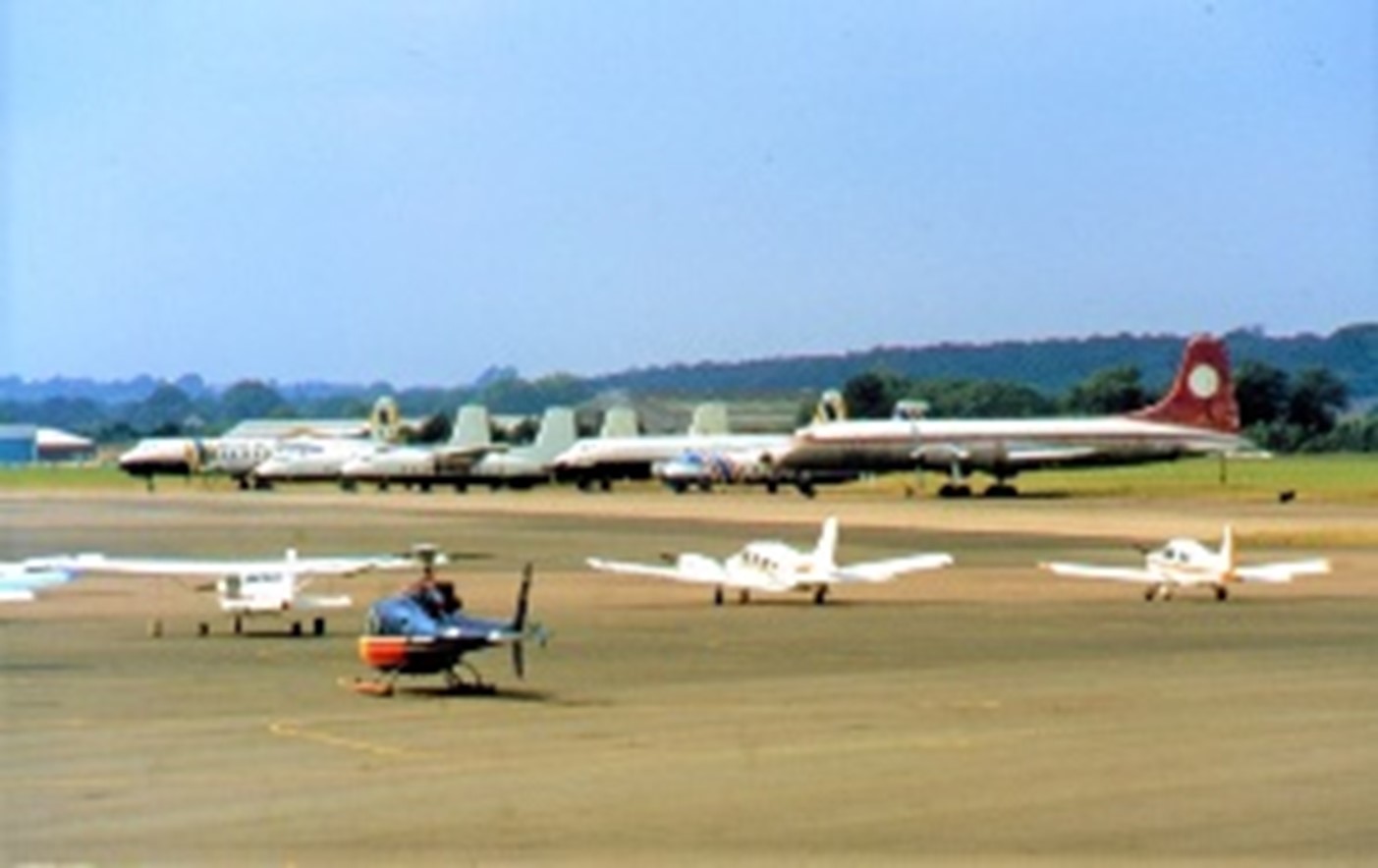
Southend Airport 1983 – We will re visit this wonderful line up 3 times during this Report
Museum 1 – The Berkshire Aviation Museum, Woodley:

Let me put it out there straight away, I really do like this museum. In terms of scale you would be forgiven for saying it is not a large museum, but what it lacks in size is more than compensated for by the shear range and quality of its exhibits. Despite being small, the enormity of the importance the museum plays in safeguarding the heritage of the County’s aviation achievements is exemplified in the fact that a handful of exhibits are sole survivors of their type, the Miles Marlinet, Miles Student and Fairey FB-1 Gyrodyne for example. Quite simply it would take you days to properly explore the collection of aviation related exhibits, it truly is a gem and should be number one on anyone’s aviation museum bucket list.
The museum is located on the south side of what was once Woodley aerodrome near Reading, home to Miles Aviation and for a short time Handley Page. Just shy of 6,000 civil and military aircraft were built and flown from this airfield between 1932 and 1962, after which the site was developed for housing and consumed by the ever-sprawling Reading. In 1939 the resident Philips and Powys factory installed the UK’s first moving track assembly line for aircraft to build the Miles Messenger advanced training aeroplane. The site was the birthplace of the Photo coping machine, and where else would you find the tip of a British nuclear intercontinental missile on display (Geiger counter not required)? Why here, because of the contribution made by many local suppliers to the industry such as Sperry who developed the navigation system for the submarine-based deterrent, thankfully thus far not tested for real.
As for my Challenge, I was drawn to the museum because of a “Tale of Two Classics”; sole survivors Miles Marathon G-AMGW and short fuselage HP Herald series 100 G-APWA. Whilst G-AMGW may not be a complete airframe, the very fact the museum has part of a Miles Marathon is nothing short of a small miracle. A miracle in the sense that a Derby Airways employee had the foresight to take a section of GW’s fuselage for use with his caravan project before the aircraft was scrapped. The caravan project was later abandoned and the section of fuselage was assigned to hen house duties on a local farm until the taken in by the local ATC unit. Eventually the hen house was returned to its birthplace at Woodley, what a story? The museum has a photograph on display of the “caravan” section being carefully cut from the rather forlorn looking aircraft before scrapping.
Question, so how do you display a slice of fuselage with no front or back to it? I had wondered on my short drive to the museum how it would look and to my amazement this slice of Miles Marathon manages to hold its own amongst other fellow exhibits. Not relegated to a corner or other out of the way place, it is used as part of the disabled friendly walkway from the museum entrance down to the exhibition floor. Pure genius, and the walkway even doubles back on itself forcing one to both enter and exit the fuselage section as a natural movement into the museum. To add to the effect, both windows on either side of the fuselage are fitted not with Perspex but colour photographs of the local landscape as it would have appeared to passengers shortly after take-off from Woodley Aerodrome. Look closely and you can just see the remnants of the Derby Airways livery on the port side above the windows.

In addition to being the sole surviving Miles Marathon, this aircraft can also claim celebrity status in that Sir Cliff Richard flew on it from Derby to RAF Kingstown located just 2nm outside Carlisle on May 2nd 1960. He was forced to hire the aircraft from Derby Airways as his car had been stolen whilst performing in Derby and he had to be in Carlisle the following day as part of his Nation-wide tour with the Shadows. Unfortunately I cannot find a photograph of him on or with the aircraft and received no response when approached regarding the matter, but please do let me know if you or your parents attended the Carlisle performance and whether or not the incident was referenced during the evenings proceedings. It is a real shame that this is all that remains of an aircraft type that formed part of the Government’s strategic plan to revitalise the nation’s civil airliner industry after WWII, but the museum has done a splendid job in keeping the Miles Marathon story alive.
My other spotting target today was the museum’s HP Herald series 100 which stands proudly on raised earthworks outside the main display building, and being slightly raised it lends itself well to photography. I never had the pleasure of flying aboard a HP Herald and was delighted when invited to take a tour of the aircraft, using the flight crew door to gain access. The interior has been restored to a very high standard and one can immediately sense what air travel must have been like as a passenger in the 1960/70s. I had read reports over the years that the HP Herald was a much roomier aircraft compared to its rivals the Fokker F27 and HS 748, and having flown on both these types in the past the extra half a meter cabin width of the HP Herald was immediately apparent giving a truly spacious interior feeling. G-APWA is a magnificent exhibit, and more to the point it is located where it was designed and built. This is the first of our 3 survivors found in the photograph taken at Southend in 1983, it is the second HP Herald from the left and can be identified by its short fuselage compared to the other 4 sister aircraft in the line-up. A memorable reunion indeed after 37 years.

G-APWA was the prototype HP Herald, one of only three aircraft built at Woodley aerodrome before production was moved to HPs main site at Radlett and one of only 4 short fuselage model 100s produced. The aircraft lay languishing at Southend airport until 1995 when it was rescued and removed to Woodley, you can watch the event here:
Comparing the state of the aircraft in the video to that of today, it is quite remarkable in deed. We owe a lot to Ken and the team at the museum for rescuing this magnificent piece of Berkshire aviation history and restoring it to its current condition.
The museum also plays tribute to White Waltham, the former home to Fairey Aviation who used the airfield to assemble and test fly aircraft built at their Hayes facility in Middlesex. Museum exhibits include the sole surviving Fairey FB-1 Rotodyne and a former Navy Fleet Air Arm Fairey Gannet, plus a splendid exhibition show scale model of the Fairey Rotodyne. This aircraft first flew from White Waltham in 1957 and was the world’s first vertical take-off and landing airliner, far ahead of its time but unfortunately not a commercial success.
The museum has a plethora of scale aviation models on display, many in the form of detailed dioramas depicting many historical and local aviation events. The quality and detail of these displays is breath-taking, and one really does feel immersed in the moment captured, whether scrambling to a waiting Spitfire or lounging in a deck chair on a sunny Berkshire afternoon watching events at Woodley aerodrome. If ever the producers of “Night at the Museum” are looking for a location for a sequel to their last film, then look no further than the Berkshire Aviation Museum.
Museum 2 – Brooklands Museum
My Challenge brings me to Brooklands to spot their entire civilian airliner collection, home to the once famous aviation manufacturer Vickers. It is pleasing that this museum pays tribute to a number of the classic aircraft manufactured on site during the 1950/ 60s including both the Brabazon Committee’s Vickers Viscount (BAF G-APIM), Vickers Vanguard (Hunting Cargo G-APEP) and Vickers VC10 (Gvt. Of Oman A40-AB). The museum is not unlike a modern day theme park as it has something for everyone, including a large collection of antique racing cars, pit stops complete with 1930 buildings, buses, and aircraft. When on site one can never forget that Brooklands was the birthplace of British motor racing, as exemplified in the following photograph with one of the racing track’s corners visible behind the Vickers Viking. Just imagine entering that bend in excess of 125mph in a 1930s race car? Sadly the runway used by the Vickers aircraft on their maiden flights has disappeared and is now used by Mercedes Benz for customer driving experience days.
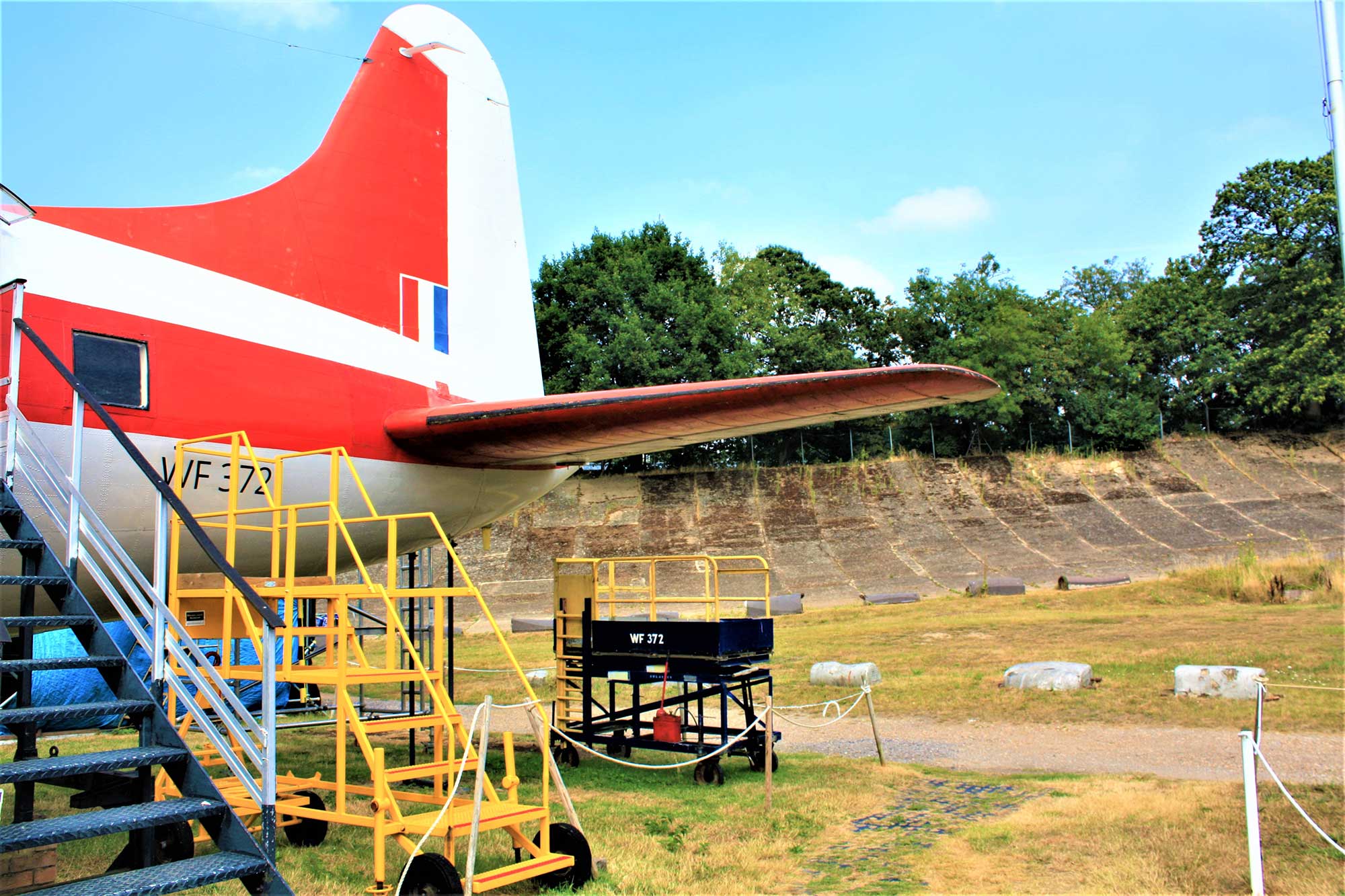
Vickers Varsity in front of the historic Brooklands race track.
The museum is home to the sole surviving Vickers Vanguard G-APEP, and I would highly recommend that you watch this video recording of this aircraft landing at Brooklands in 1996:
Not only does the video superbly capture the last ever landing made by a Vickers Vanguard, but also explains what could have happened if the aircraft had touched down just a few feet to the left! I’m not going to spoil the story for those who haven’t seen the video, but the interview with the landing Pilot after the event is priceless.
Very selfishly I rushed straight for the museum’s collection of classic British airliners, including a Vickers Viscount which as we all know was one of the more successful Brabazon Committee creations. According to Captain’s Log, Stardate 19.8.3, Viscount G-APIM turns out to be the second survivor from the photograph taken at Southend back in 1983. The aircraft was retrieved from Southend in 1995 shortly after being badly damaged by a taxiing Shorts SD3-30 and thankfully later taken to Brooklands for repair and eventual exhibition. Later the aircraft was named “Viscount Stephen Piercy” in memory of the founder and first editor of the magazine Propliner, most definitely one of my favourite publications over the last 35 years.
I do have soft spot for a Vickers Viscount as Cambrian Airways variants featured on every teenage spotting visit to Speke, and during the long turn-around times of that era we were often allowed on board and sat in a passenger seat dreaming of flying somewhere exotic. I told one of my former spotting friends that I was visiting Brooklands and he shared a childhood Viscount experience he had whilst returning to Speke from Ronaldsway on a Cambrian Airways Vickers Viscount in 1966. Shortly before landing the pilot announced that the undercarriage had not fully extended and that a member of crew would attempt to ratify the problem. Within minutes an air hostess appeared from the flight deck with a meter long metal undercarriage “handle” and took up position next to my friend who was sitting in the aisle next to what appeared to be the access point to the main undercarriage. She rolled back the floor carpet, opened a hatch revealing the Irish Sea and promptly attached the handle to some mechanism and cranked away until the undercarriage was fully extended. The hatch was closed and the undercarriage handle dutifully returned to where ever such tools are stored on a Viscount flight deck.
Imagine something similar happening during a flight today? The entire world would know before the fault had been rectified and the local paparazzi would be waiting at the airport to record every “tense” moment before touchdown. Never mind the 10 year old boy calmly sitting adjacent to the gaping hole in the aisle! Whilst on the subject of the IOM, I will be visiting Ronaldsway in 2021 as part of this Challenge in order to spot the Manx Airlines Embraer Banderantie owned by the resident Manx Aviation and Military Museum, combining the visit with Manchester Airport to spot HS Trident 3 G-AWZK and prototype BAe RJX100 G-IRJX.
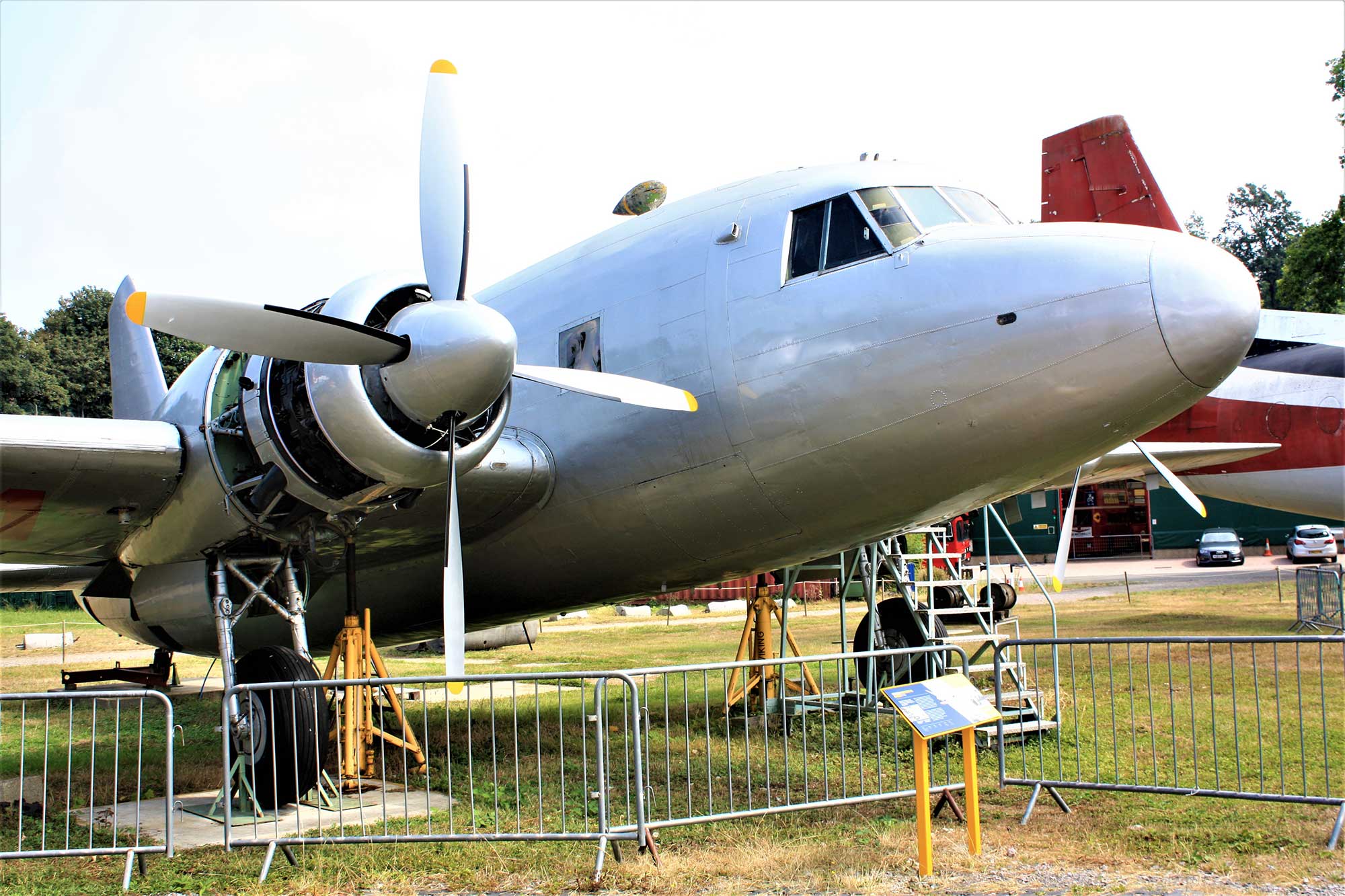
Vickers Viking at Brooklands.


The museum also has a resident Concorde, prototype G-BBDG. I was fortunate enough to be part of the many thousands of Spotters that flocked to Heathrow on October 24th, 2003 to witness the final ever landing of a Concorde at the airport. Along with my video camera and Broadband radio (not the 1968 variant) I managed to record the final landing including several emotional over the air exchanges between the landing pilot and Air Traffic Controller. Sadly I cannot share that footage with you today as I lost the video tape during a house burglary not long after the event. Seeing Concorde close up brought back all those fond memories of seeing (and hearing!) the aircraft take-off and land from airports as diverse as Speke, Grantley Adams and especially Heathrow on that day in 2003. This particular Concorde can boast that it was the world’s first aircraft to carry 100 passengers supersonic and is a very proud exhibit.
The museum has eight complete airliner airframes on display, all of which were required as part my Challenge. The Government of Oman Vickers VC10 has the standard length fuselage and was the last non-military Vickers VC10 to fly. Unfortunately access to the cabin was not permissible due to Covid restrictions, the same rule also applied to the Vickers Viscount, Vickers Vanguard and BAC 1-11 G-ASYD on the day. It was pleasing to spot a short fuselage BAC 1-11 as it brought back memories of the flights I took regularly between Dublin and Liverpool with Aer Lingus right up to the type’s retirement in 1991. This aircraft first flew in 1965 as the series 400 prototype and spent its entire operational life with British Aerospace and was finally retired in 1993.
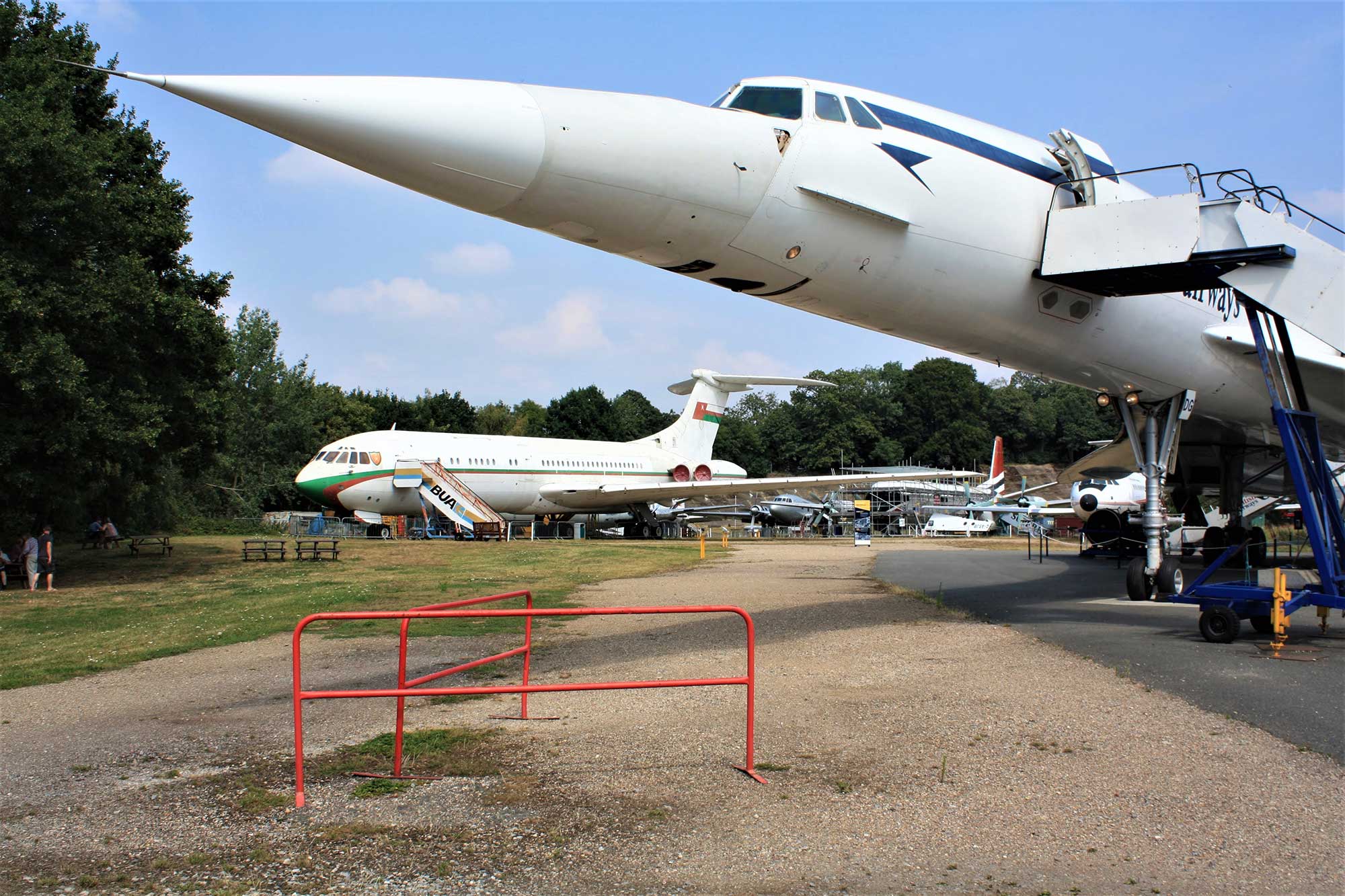
Concorde and Vickers VC10 at Brooklands.

BAC 1-11 prototype at Brooklands Museum.
Museum 3 – De Havilland Aviation Museum – Salisbury Hall
Continuing the theme of visiting museums on or close to the home of an original aircraft design and manufacturing site, Salisbury Hall in London Colney is next on this spotting Trip. Whilst not actually located on the original de Havilland manufacturing facility at Hatfield, Salisbury Hall is significant in that this building was chosen by the company to “secretly” locate the DH Mosquito design team in September 1939. The prototype aircraft was designed and assembled on site before being taken by road on the short 6 mile journey to Hatfield for its maiden flight.
Boasting the world’s largest collection of the type, the museum is certainly DH Mosquito centric and there is nothing wrong with that. The wider collection of aircraft exhibits pay tribute to the significant role that De Havilland played in post WWII aviation design and development including two Brabazon Committee creations. Firstly the fuselage of F-BGNX, the third production DH Comet and sole surviving type with “rectangular” windows, and DH Dove G-AREA once used by De Havilland as the types’ Company demonstrator. All splendid in period Air France livery, F-BGNX is a spectacle to be seen and what hits you immediately is just how advanced this aircraft was for the time. We are all familiar with the structural problems the DH Comet initially suffered from and should be grateful that the lessons learnt have been incorporated into every pressurised airliner we take to the sky in today.

Comet 1 F-BGNX at the de Havilland Museum.
Unfortunately, F-BGNX is quite difficult to photograph as it is located adjacent to an exterior wall with the nose section wedged both between the wall and a stanchion supporting a mezzanine floor used for presentations purposes. Hopefully I have caught some of the beauty beheld by this magnificent pioneering aircraft and that you notice something familiar with a certain twin engine jet aircraft from across the Channel? Would it be possible to mistake this photograph for an early Air France Caravelle? Most certainly, and that is because De Havilland shared the complete nose and flight deck with Sud Aviation who used it in the design and manufacture of their Caravelle. The reasoning behind this was straight forward, both Air France and UTA had operated the DH Comet and using a proven concept would not only speed up the design and manufacture of the new aircraft but also be familiar to pilots from both airlines. Many of the Sud Aviation design team later moved to Airbus and perhaps the Caravelle was the birthplace for the design idea behind the common aircraft flight deck layouts and ratings pioneered across the future range of Airbus airliner types?
I am certainly not averse to military aircraft, but my personal bent is Civil Airliners and that was the primary purpose of my visit to Salisbury Hall today. In addition to the DH Comet 1 and De Havilland Company Demonstrator DH Dove, the collection includes DH 125-1 G-ARYC, DH Heron G-AOTI and fuselages of HS Trident 2 G-AVFH and HS 146-100 G-JEAO. The DH Heron is adorned in that late 1960s/ early 1970s marina blue colour which made me chuckle as it is identical to the 1971 VW Beetle languishing in my garage, now that would make a splendid period photograph in my garden. Let us not forget how successful the DH Dove was in commercial terms, selling 542 examples and in its stretched format formed the basis of the DH Heron which added an additional 148 units to the combined production run.



I used to commute regularly between Essex and Windsor along the M25 during the late 1980s and on one occasion recall seeing all three HS.146 models flying in formation at low level towards Hatfield. That would certainly have been a coup had it happened today, then I could have spotted all three types in one place! It was most pleasing to spot the DH Comet, DH Dove, DH Heron and DH 125 in their spiritual resting place at Salisbury Hall. By the way, the DH Mosquitos are well worth seeing, they have such presence the way they are exhibited.
Museum 4 – IWM Duxford

Duxford is Europe’s largest aviation museum and certainly feels so with an extensive line of exhibition hangers including some used during WWII and more recent facilities dedicated to British aviation history and that of the USAFE. It also felt rather special too visiting the museum just after the 80th anniversary of the Battle of Britain and seeing fine examples of both Spitfires, Hurricanes and Messerschmitt Bf 109s on display. The museum is home to several Brabazon Committee creations including Vickers Viscount 700 G-ALWF (as seen in the Pathe News clip earlier), Airspeed Ambassador G-ALZO and DH Comet 4 G-APDB together with a fine line up of 1960s classic British Airliners including HP Herald 200 G-APWJ, HS Trident 2 G-AVFB, BAC 1-11 500 G-AVMU and Bristol Britannia G-AOVT.
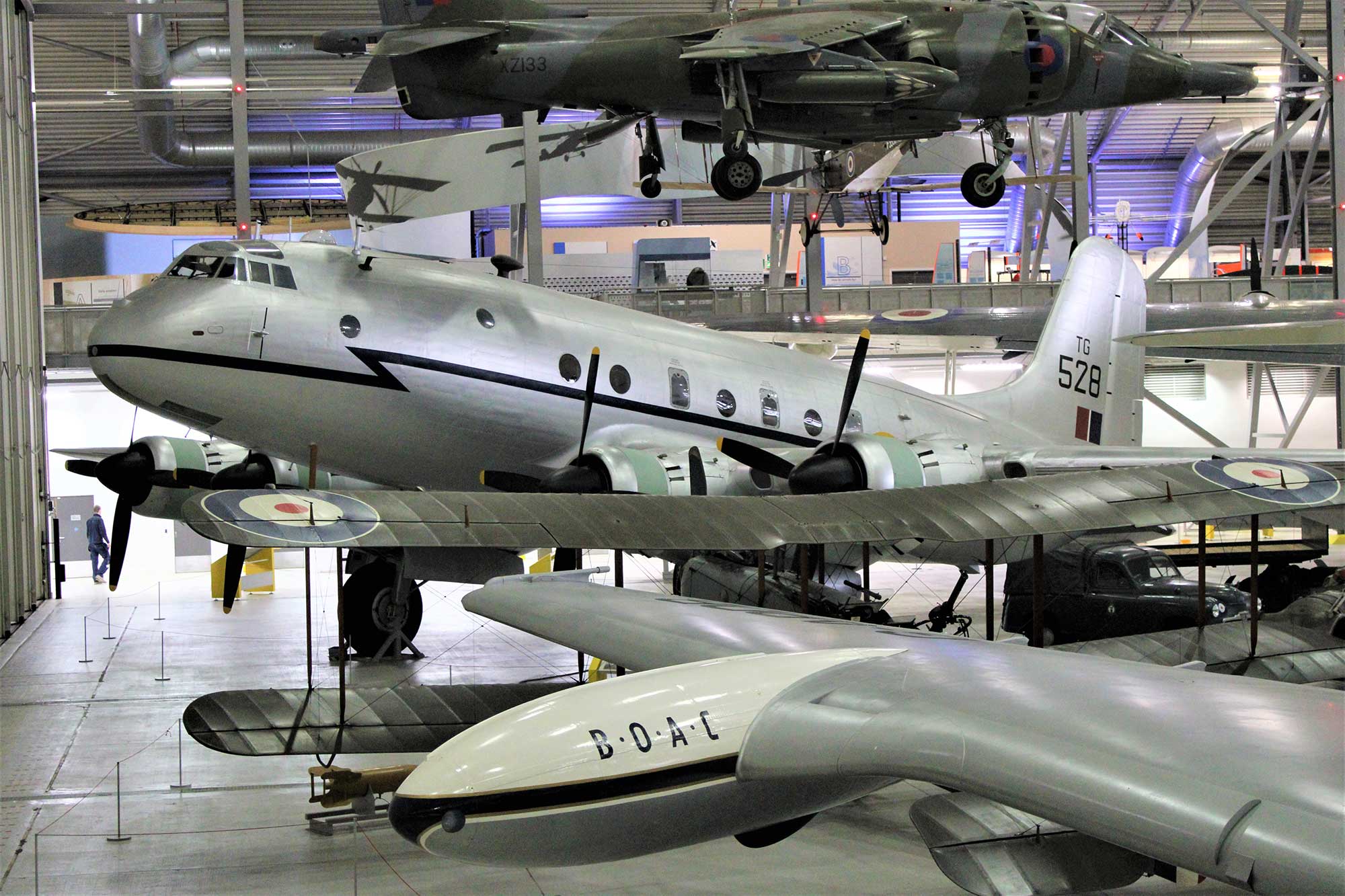
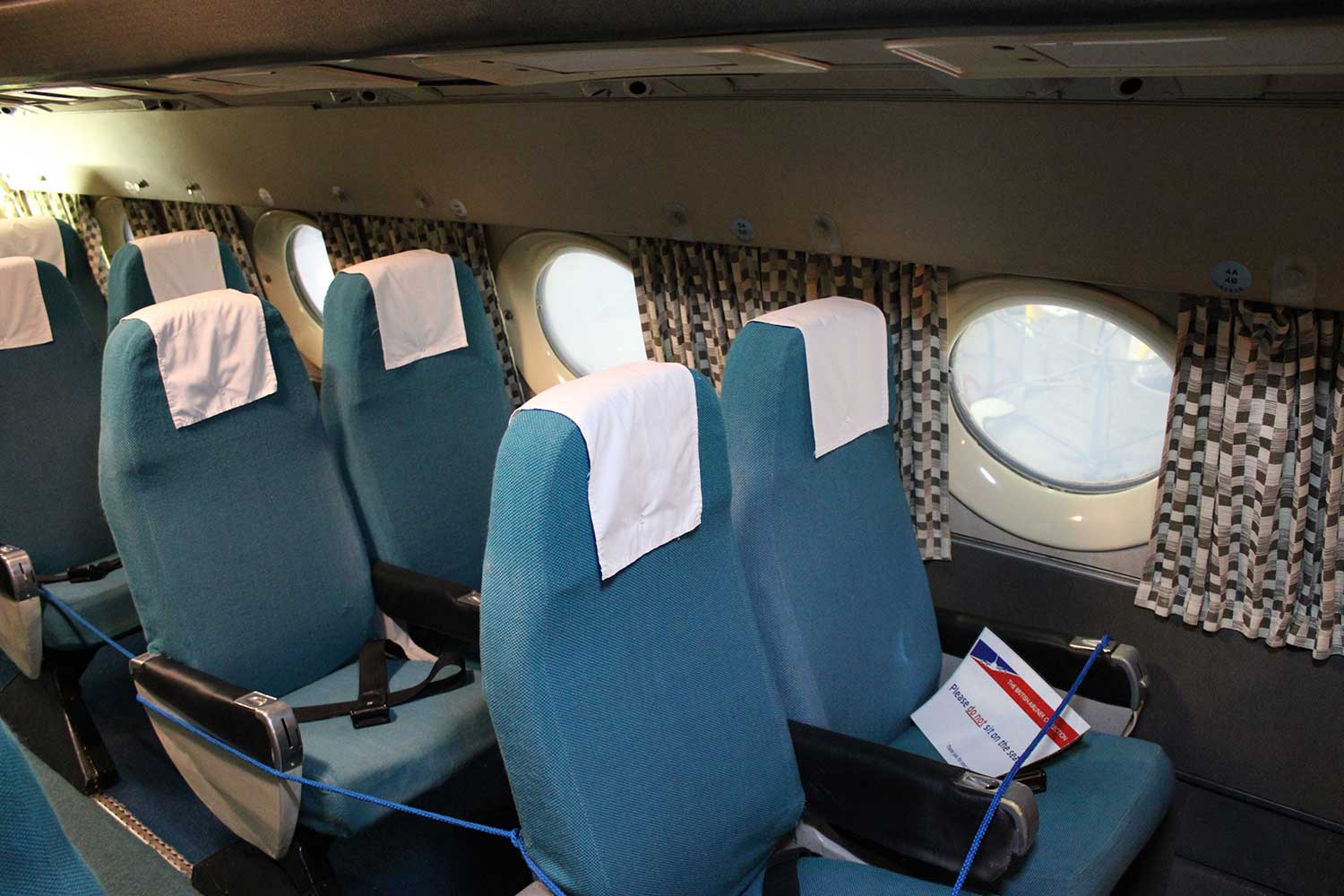
Comet 4B interior
The hangar dedicated to WWII and post war British aircraft is a delight, and thankfully I was able to take a look inside magnificent BOAC Comet 4. The following photograph clearly illustrates the leg room afforded Economy passengers in 1958, with each row of seats having one of the gigantic oval windows to themselves. Comet 4 G-APDB was the first jet air liner to cross the Atlantic nonstop, and the flight deck recording of the exchange between the pilot and the ATC tower is fascinating. The pilot repeatedly reminds ATC that the aircraft is jet powered, such a novelty it must have been at Heathrow at the time. The hangar is also home to another Brabazon Committee creation, the magnificent Dan Air Avro York G-ANTK which is displayed with huge freight doors open and looking most purposeful. You will also be able to spot the fuselage of BOAC HP Hermes G-ALDG in the hangar along with the immaculately adorned DH Dove G-ALFU suspended in flight from the rafters.
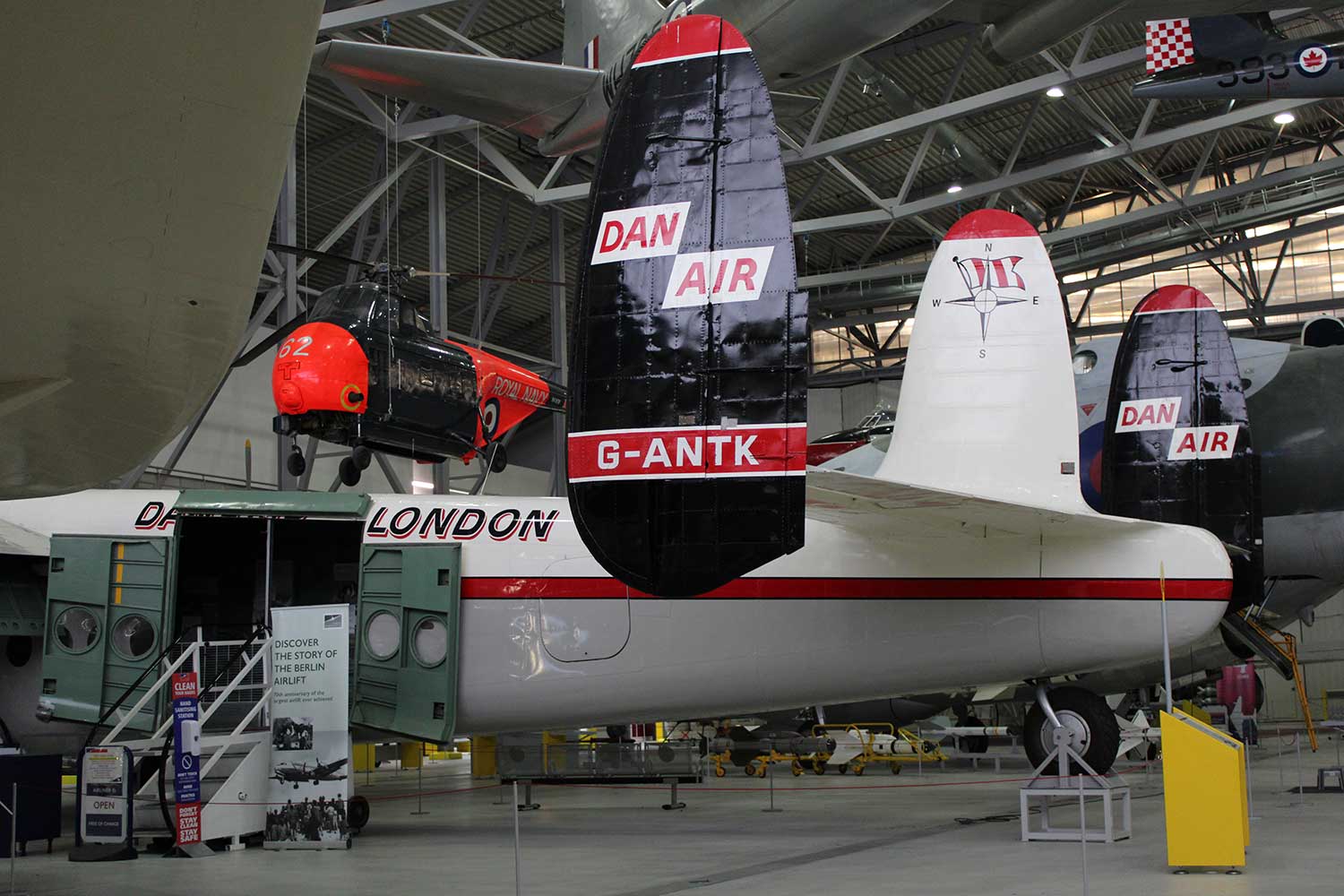
Dan Air Avro York at Duxford

Walking the long line of classic British airliners adjacent to the display hangars is magnificent with fabulous photograph opportunities available from both the front and rear of the line. With reduced visitor numbers due to Covid restrictions, now is the time for some photography without unwanted humans in the shot! Vickers Viscount 700 G-ALWF (the dual personality aircraft in the Pathe News footage), BAC 1-11 500 VMU, HS Trident 2 G-A VFB and Vickers Super VC10 G-ASGC provide BEA/ BOAC/ British Airways colour schemes from the 1950s right through to the late 1990s. It is a pity the weather was not on my side when walking the line, but still the array of liveries is magnificent. The Vickers VC10 is resplendent in the colours of the aircraft I flew on in 1973 with BOAC when travelling to Toronto from Manchester via Prestwick. This turned out to be a most eventful flight for a young spotter as upon landing at Prestwick the aircraft experienced a reverse thrust malfunction and we came to a shuddering halt on the runway. The pilot explained that we could not fly on to Toronto and that we would need to fly to Heathrow to pick up a replacement VC10 aircraft. What a shame, all in a day’s spotting I thought selfishly! Manchester to Prestwick, Prestwick to Heathrow, Heathrow to Toronto and all in a day’s flying and on two different Super VC10s. Unfortunately I never flew on G-ASVC displayed at Duxford but BAC 1-11 G-AVMU was a regular stead once upon a time.
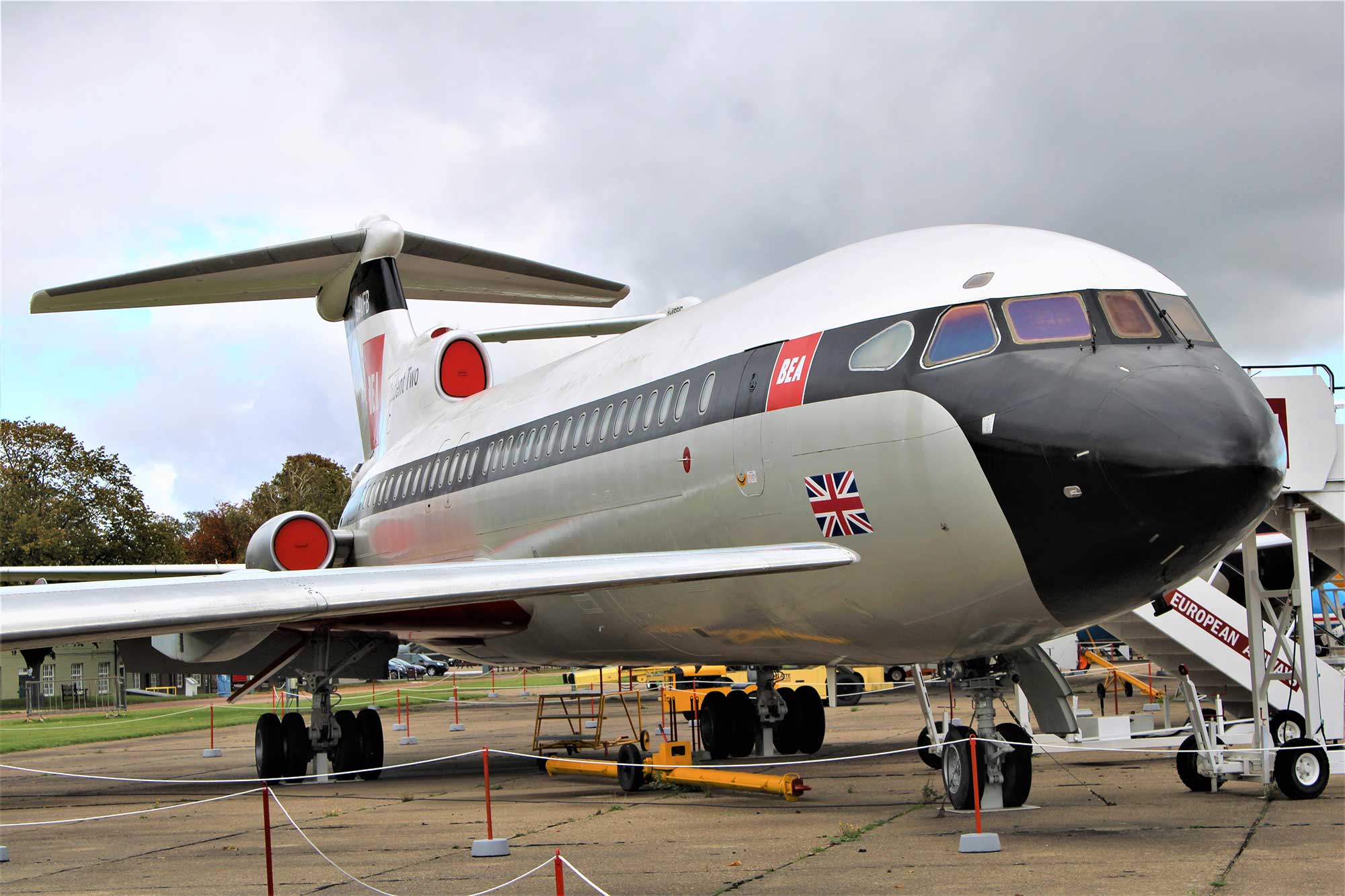
Trident 2E at Duxford
British Airways had just retired its Trident fleet when I started flying regularly on business and I never managed to fly on one. My work took me to Dublin on a regular basis for a time and I have fond memories of my British Airways BAC 1-11 500 flights between Heathrow and Dublin, including one such flight during 1988 when we had to return to Heathrow after take-off due to a faulty under carriage warning. No “under carriage handle” on this modern jet airliner, so we returned to Heathrow and dutifully put runway 27R out of action for several hours. Passengers still wishing to continue the journey to Dublin were offered the services of a Boeing 757 that was quickly commissioned for the flight, and about 20 of us enjoyed the spacious replacement aircraft and enjoyed copious amounts of champagne on the short flight.
Each aviation museum visited on this spotting trip had something different to offer and experience, and Duxford is no exception. In addition to the magnificent collection of civil airliners on display the museum also boasts an active runway, and whilst savouring the delights of the civil airliner line up adjacent to the runway I was treated to a Catalina performing repeated touch and goes. What more could you ask for on a dreary October afternoon in Cambridgeshire?
My fifth and final museum on this trip was meant to be RAF Cosford to spot the collection of British post WWII military transport aircraft needed as part of my Challenge. Unfortunately this was not to be, but it does provide the opportunity before concluding to mention one specific exhibit at Cosford dear to my heart. We return for the third and final time to the 1983 photograph taken at Southend and specifically to the Bristol Britannia standing head held high at the front of the line-up. This was the former Invicta airlines G-AOVF and (you guessed correctly) it is now on display at RAF Cosford. The aircraft was flown out of Southend in 1984 to Kemble and then onto Cosford later the same year. Those that have visited Cosford will recognise the aircraft as XM497 in RAF Transport colours, I will have to wait a little longer before being re-united with the aircraft after a 37 year absence.
Conclusion
Much has been written in the public domain regarding the Brabazon Committee and the aircraft that it spawned, largely derogatory. The future airliner market envisaged by the Committee through its Empire tinted glasses changed both politically and technologically in an instance, and I do believe that the Committee was always on the back foot considering the lead the USA had over the rest of the world in 1945 in terms of transport and airliner development.
Some 80 years later this spotting trip reinforces the fact that literally I am just an observer when it comes to the Brabazon Committee and its recommendations. The debate regarding the rights and wrongs of the Committee is complex, but what this trip has brought home to me is that there were some seriously talented aircraft designers and engineers in the UK during this period. The Committee was actually responsible for several commercial successes in both the Vickers Viscount and DH Dove, and whilst not a commercial success de Havilland took large airliner development to a whole new level both in terms of propulsion and airframe technology with the Comet 1. The aviation world sat back and diligently observed whilst De Havilland corrected the catastrophic structural problems associated with early Comet models and later implemented all the hard-earned learning from Hatfield into their first jet age products. De Havilland produced a truly spectacular aircraft in the Comet.
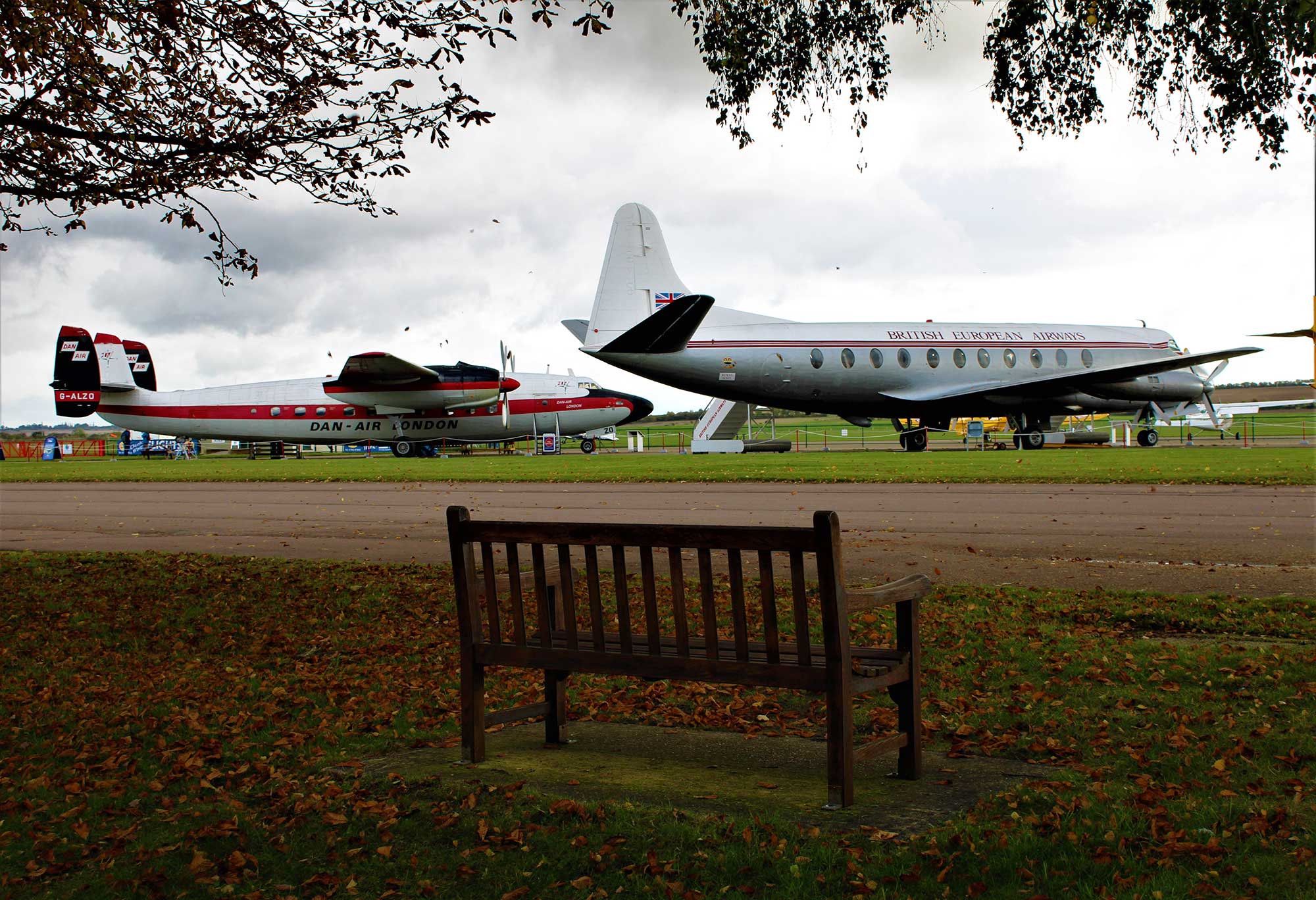
Ambassador and Viscount at Duxford
The Airspeed Ambassador arrived late to the market and had the wrong engines when the airliner world had been wooed by the smoothness of flight offered by turbine technology. It did however go on to allow Dan Air to prosper as an Independent airline and become a key player in the early development of the UK package holiday industry. Let us not forget the Avro York, one of the Committee’s interim solutions. This robust aircraft was a major component of the Berlin Airlift efforts, and between 1948-49 flew 58,000 sorties to the city carrying over a million tons of freight. When released from RAF duties, 40 aircraft were sold on to civilian operators such as Skyways and Dan Air who continued to operate the type up to 1964. The Dan Air example G-ANTK Spotted at Duxford is one of only two complete surviving airframes.
I believe that the real damage inflicted on the British large airliner industry happened during the 1960s and 1970s. Pampering to the whims of BEA and BOAC management during aircraft design (Vickers VC10 & HS Trident), an obsession with supersonic travel (diverting development and financial resources away from successful programmes such as the BAC 1-11), and finally Nationalisation. For me it was the disastrous decision made by the Government in 1969 not to become a full member of Airbus Industrie, thus abandoning the UK from participation in the design and assembly of any future large airliner programmes. It was a privilege to walk the line at Duxford looking up at the tall standing “T” tails of those classic 1960/70s British airliners, their registrations looked as exciting today as when I first entered them into my log book at the time.
Perhaps the UK aviation industry needs another Brabazon Committee moment, oh no I hear many of you call out as you take to the keyboard. Well actually it has already started with the publication of the “Aviation 2050” consultation document by the Government in December 2018. Thankfully UK industry is in a very different place this time around, good ideas can attract both the correct partner and access to the correct level of funding without having to do invent or do everything oneself. The document encourages the aviation sector to anticipate future developments and not just invest in known technologies. Where there is tea there is hope.
Whilst this spotting trip did not include any exotic airliners or biz-jets from far-away places, it did enable me to re-engage with past spotting experiences and re-discover the aircraft types that used to excite me as much as the modern types do today. In addition it offered the chance to see many of the aircraft types that were the brain child of the Brabazon Committee and varying politicians/ governments of all stripes. From my spotting challenge perspective the trip was highly successful with 26 aircraft types struck off the list including post WWII piston spectacles such as the Airspeed Ambassador and Avro Hastings, through to the jet airliner marvels of the 1960s with the Vickers VC10 and HS Trident. As for a favourite aircraft, you might think it unfair to all the museums if I single out one type. Having said that I do know that no two spotters are like minded and we all have our favourite child(ren). It was the DH Comet, now there you have it and I still have the sole surviving Comet 1 with retro-fitted oval windows to spot at Cosford.
Stay safe and go visit the aviation museums if you can, they are a must for any spotter.





2 comments
Hello Matt
Many thanks for a fascinating piece, which stirred many memories of my own (photographically much less successful) visits to the same museums. Hoping they can resume one day…. A shame that you didn’t get to Cosford – the other hangars are still open, well until Wednesday, anyway.
The Airspeed Ambassador is not my favourite aeroplane, but is certainly my most nostalgic one, as my very first flight was on one – a BEA flight from Hamburg to Berlin in 1964. BEA, of course, called it the Elizabethan. What a weekend – flying for the first time, going behind the Iron Curtain, a deserted Unter den Linden in the East, shops full of nothing and nobody, being so pleased to be able to walk back through Checkpoint Charlie – a total sensory and mental overload. I must use the next four weeks to get up in the loft and find those photographs.
Thanks again -I enjoy all your items, but especially I love your Trip reports.
Thanks Mike, glad you enjoyed. Just to clarify, it was John Madden who made the trip and not me. I’m sure he’s reading these comments.
Matt